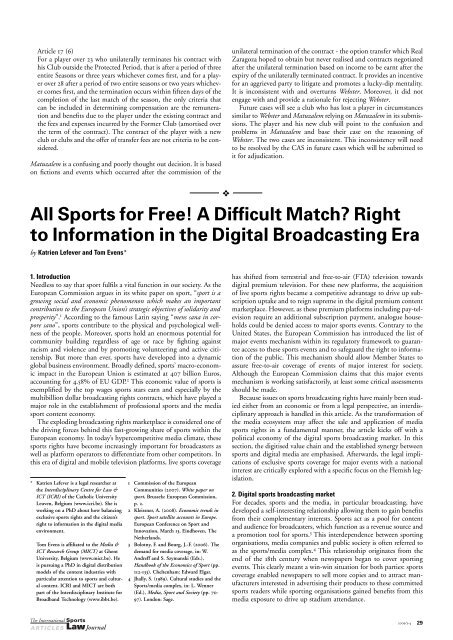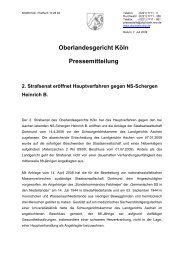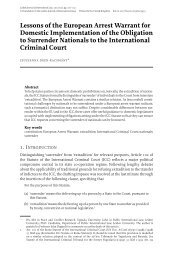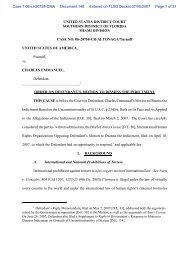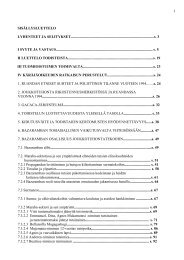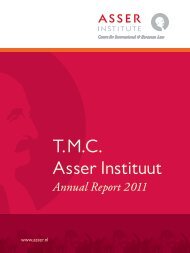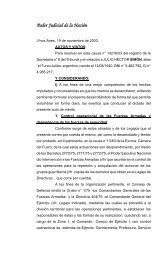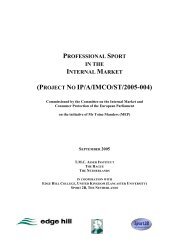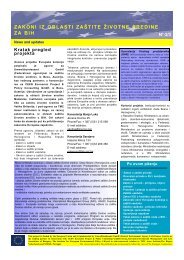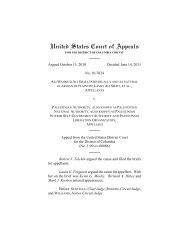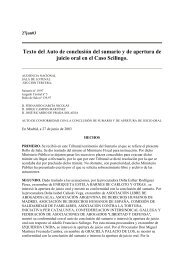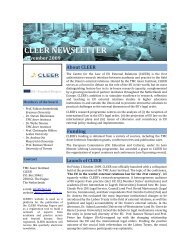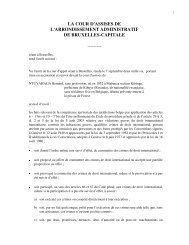Islj 2009 3-4 - TMC Asser Instituut
Islj 2009 3-4 - TMC Asser Instituut
Islj 2009 3-4 - TMC Asser Instituut
You also want an ePaper? Increase the reach of your titles
YUMPU automatically turns print PDFs into web optimized ePapers that Google loves.
Article 17 (6)<br />
For a player over 23 who unilaterally terminates his contract with<br />
his Club outside the Protected Period, that is after a period of three<br />
entire Seasons or three years whichever comes first, and for a player<br />
over 28 after a period of two entire seasons or two years whichever<br />
comes first, and the termination occurs within fifteen days of the<br />
completion of the last match of the season, the only criteria that<br />
can be included in determining compensation are the remuneration<br />
and benefits due to the player under the existing contract and<br />
the fees and expenses incurred by the Former Club (amortised over<br />
the term of the contract). The contract of the player with a new<br />
club or clubs and the offer of transfer fees are not criteria to be considered.<br />
Matuzalem is a confusing and poorly thought out decision. It is based<br />
on fictions and events which occurred after the commission of the<br />
unilateral termination of the contract - the option transfer which Real<br />
Zaragoza hoped to obtain but never realised and contracts negotiated<br />
after the unilateral termination based on income to be earnt after the<br />
expiry of the unilaterally terminated contract. It provides an incentive<br />
for an aggrieved party to litigate and promotes a lucky-dip mentality.<br />
It is inconsistent with and overturns Webster. Moreover, it did not<br />
engage with and provide a rationale for rejecting Webster.<br />
Future cases will see a club who has lost a player in circumstances<br />
similar to Webster and Matuzalem relying on Matuzalem in its submissions.<br />
The player and his new club will point to the confusion and<br />
problems in Matuzalem and base their case on the reasoning of<br />
Webster. The two cases are inconsistent. This inconsistency will need<br />
to be resolved by the CAS in future cases which will be submitted to<br />
it for adjudication.<br />
❖<br />
All Sports for Free! A Difficult Match? Right<br />
to Information in the Digital Broadcasting Era<br />
by Katrien Lefever and Tom Evens*<br />
1. Introduction<br />
Needless to say that sport fulfils a vital function in our society. As the<br />
European Commission argues in its white paper on sport, “sport is a<br />
growing social and economic phenomenon which makes an important<br />
contribution to the European Union’s strategic objectives of solidarity and<br />
prosperity”. 1 According to the famous Latin saying “mens sana in corpore<br />
sano”, sports contribute to the physical and psychological wellness<br />
of the people. Moreover, sports hold an enormous potential for<br />
community building regardless of age or race by fighting against<br />
racism and violence and by promoting volunteering and active citizenship.<br />
But more than ever, sports have developed into a dynamic<br />
global business environment. Broadly defined, sports’ macro-economic<br />
impact in the European Union is estimated at 407 billion Euros,<br />
accounting for 4.58% of EU GDP. 2 This economic value of sports is<br />
exemplified by the top wages sports stars earn and especially by the<br />
multibillion dollar broadcasting rights contracts, which have played a<br />
major role in the establishment of professional sports and the media<br />
sport content economy.<br />
The exploding broadcasting rights marketplace is considered one of<br />
the driving forces behind this fast-growing share of sports within the<br />
European economy. In today’s hypercompetitive media climate, these<br />
sports rights have become increasingly important for broadcasters as<br />
well as platform operators to differentiate from other competitors. In<br />
this era of digital and mobile television platforms, live sports coverage<br />
* Katrien Lefever is a legal researcher at<br />
the Interdisciplinary Centre for Law &<br />
ICT (ICRI) of the Catholic University<br />
Leuven, Belgium (www.icri.be). She is<br />
working on a PhD about how balancing<br />
exclusive sports rights and the citizen’s<br />
right to information in the digital media<br />
environment.<br />
Tom Evens is affiliated to the Media &<br />
ICT Research Group (MICT) at Ghent<br />
University, Belgium (www.mict.be). He<br />
is pursuing a PhD in digital distribution<br />
models of the content industries with<br />
particular attention to sports and cultural<br />
content. ICRI and MICT are both<br />
part of the Interdisciplinary Institute for<br />
Broadband Technology (www.ibbt.be).<br />
1 Commission of the European<br />
Communities (2007). White paper on<br />
sport, Brussels: European Commission,<br />
p. 2.<br />
2 Kleissner, A. (2008). Economic trends in<br />
sport. Sport satellite accounts in Europe.<br />
European Conference on Sport and<br />
Innovation, March 13, Eindhoven, The<br />
Netherlands.<br />
3 Bolotny, F. and Bourg, J.-F. (2006). The<br />
demand for media coverage, in: W.<br />
Andreff and S. Szymanski (Eds.),<br />
Handbook of the Economics of Sport (pp.<br />
112-133). Cheltenham: Edward Elgar.<br />
4 Jhally, S. (1989). Cultural studies and the<br />
Sports/media complex, in: L. Wenner<br />
(Ed.), Media, Sport and Society (pp. 70-<br />
97). London: Sage.<br />
has shifted from terrestrial and free-to-air (FTA) television towards<br />
digital premium television. For these new platforms, the acquisition<br />
of live sports rights became a competitive advantage to drive up subscription<br />
uptake and to reign supreme in the digital premium content<br />
marketplace. However, as these premium platforms including pay-television<br />
require an additional subscription payment, analogue households<br />
could be denied access to major sports events. Contrary to the<br />
United States, the European Commission has introduced the list of<br />
major events mechanism within its regulatory framework to guarantee<br />
access to these sports events and to safeguard the right to information<br />
of the public. This mechanism should allow Member States to<br />
assure free-to-air coverage of events of major interest for society.<br />
Although the European Commission claims that this major events<br />
mechanism is working satisfactorily, at least some critical assessments<br />
should be made.<br />
Because issues on sports broadcasting rights have mainly been studied<br />
either from an economic or from a legal perspective, an interdisciplinary<br />
approach is handled in this article. As the transformation of<br />
the media ecosystem may affect the sale and application of media<br />
sports rights in a fundamental manner, the article kicks off with a<br />
political economy of the digital sports broadcasting market. In this<br />
section, the digitised value chain and the established synergy between<br />
sports and digital media are emphasised. Afterwards, the legal implications<br />
of exclusive sports coverage for major events with a national<br />
interest are critically explored with a specific focus on the Flemish legislation.<br />
2. Digital sports broadcasting market<br />
For decades, sports and the media, in particular broadcasting, have<br />
developed a self-interesting relationship allowing them to gain benefits<br />
from their complementary interests. Sports act as a pool for content<br />
and audience for broadcasters, which function as a revenue source and<br />
a promotion tool for sports. 3 This interdependence between sporting<br />
organisations, media companies and public society is often referred to<br />
as the sports/media complex. 4 This relationship originates from the<br />
end of the 18th century when newspapers began to cover sporting<br />
events. This clearly meant a win-win situation for both parties: sports<br />
coverage enabled newspapers to sell more copies and to attract manufacturers<br />
interested in advertising their products to these committed<br />
sports readers while sporting organisations gained benefits from this<br />
media exposure to drive up stadium attendance.<br />
A RT I C L E S<br />
<strong>2009</strong>/3-4 29


